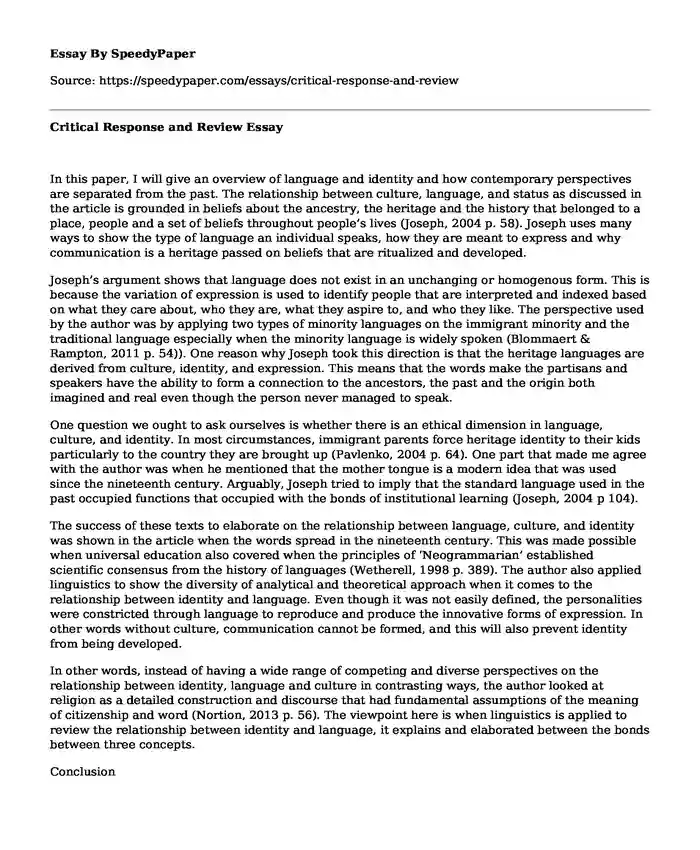
| Type of paper: | Creative writing |
| Categories: | History Human resources Research Personality |
| Pages: | 3 |
| Wordcount: | 684 words |
In this paper, I will give an overview of language and identity and how contemporary perspectives are separated from the past. The relationship between culture, language, and status as discussed in the article is grounded in beliefs about the ancestry, the heritage and the history that belonged to a place, people and a set of beliefs throughout people's lives (Joseph, 2004 p. 58). Joseph uses many ways to show the type of language an individual speaks, how they are meant to express and why communication is a heritage passed on beliefs that are ritualized and developed.
Joseph's argument shows that language does not exist in an unchanging or homogenous form. This is because the variation of expression is used to identify people that are interpreted and indexed based on what they care about, who they are, what they aspire to, and who they like. The perspective used by the author was by applying two types of minority languages on the immigrant minority and the traditional language especially when the minority language is widely spoken (Blommaert & Rampton, 2011 p. 54)). One reason why Joseph took this direction is that the heritage languages are derived from culture, identity, and expression. This means that the words make the partisans and speakers have the ability to form a connection to the ancestors, the past and the origin both imagined and real even though the person never managed to speak.
One question we ought to ask ourselves is whether there is an ethical dimension in language, culture, and identity. In most circumstances, immigrant parents force heritage identity to their kids particularly to the country they are brought up (Pavlenko, 2004 p. 64). One part that made me agree with the author was when he mentioned that the mother tongue is a modern idea that was used since the nineteenth century. Arguably, Joseph tried to imply that the standard language used in the past occupied functions that occupied with the bonds of institutional learning (Joseph, 2004 p 104).
The success of these texts to elaborate on the relationship between language, culture, and identity was shown in the article when the words spread in the nineteenth century. This was made possible when universal education also covered when the principles of 'Neogrammarian' established scientific consensus from the history of languages (Wetherell, 1998 p. 389). The author also applied linguistics to show the diversity of analytical and theoretical approach when it comes to the relationship between identity and language. Even though it was not easily defined, the personalities were constricted through language to reproduce and produce the innovative forms of expression. In other words without culture, communication cannot be formed, and this will also prevent identity from being developed.
In other words, instead of having a wide range of competing and diverse perspectives on the relationship between identity, language and culture in contrasting ways, the author looked at religion as a detailed construction and discourse that had fundamental assumptions of the meaning of citizenship and word (Nortion, 2013 p. 56). The viewpoint here is when linguistics is applied to review the relationship between identity and language, it explains and elaborated between the bonds between three concepts.
Conclusion
Language, culture, and identity are concepts known to thrive together. The relationship between culture, language and status as discussed in the article is grounded in beliefs about the ancestry, the heritage, and history. Even though it was not easily defined, the identities were constricted through language to reproduce and produce the innovative forms of expression.
References
Blommaert, J. and Rampton, B. (2011). 'Language and superdiversity', Diversities, 13(2) [Online]. Available at www.unesco.org/shs/diversities/vol13/issue2/art1Joseph, J.E. (2004). Language and identity: national, ethnic, religious. Houndmills, Basingstoke and New York: Palgrave Macmillan.
Norton, B. (2013). Identity and language learning: extending the conversation. 2nd edn. Bristol: Multilingual Matters. (A poststructuralist perspective on the relationship between identity construction and second language learning.)
Pavlenko, A. (2004). Gender and sexuality in foreign and second language education: critical and feminist approaches, in B. Norton and K. Toohey (eds) Critical pedagogies and language learning . New York: Cambridge University Press, pp. 53-71.
Wetherell, M. (1998). 'Positioning and interpretative repertoires: conversation analysis and poststructuralism in dialogue', Discourse and Society, 9: 387-412.
Cite this page
Critical Response and Review. (2022, Dec 15). Retrieved from https://speedypaper.net/essays/critical-response-and-review
Request Removal
If you are the original author of this essay and no longer wish to have it published on the SpeedyPaper website, please click below to request its removal:
- Comparison Essay Sample on Jan Eyck's and Donatello's Portraits
- Sport Essay Example: Cricket Versus Baseball
- The Role of Midwife from Legal and Ethical Perspective, Essay Example
- Free Essay on the Application of Artificial Intelligence
- Free Essay Describing the Nutrorims' Managerial Case Study
- Paper Example: Financial Statement Audit
- Report on Navigating Healthcare Decisions: A Comprehensive Exploration of Family Involvement and Personal Experiences
Popular categories




